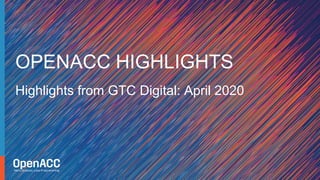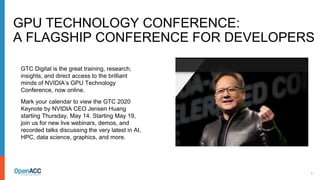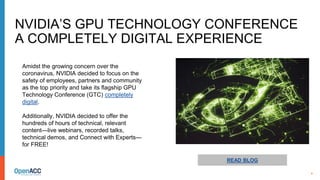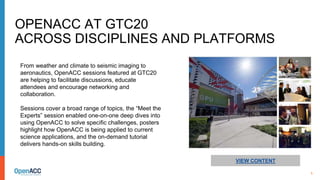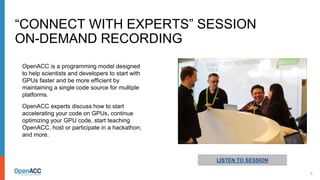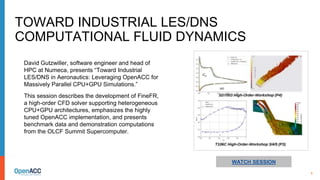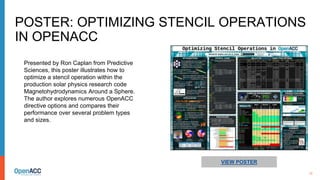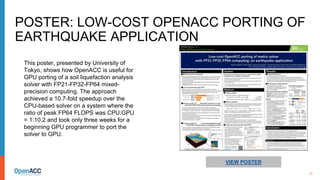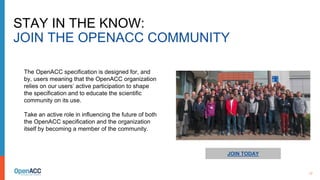OpenACC Highlights: GTC Digital April 2020
- 1. Highlights from GTC Digital: April 2020 OPENACC HIGHLIGHTS
- 2. 2 WHAT IS OPENACC? main() { <serial code> #pragma acc kernels { <parallel code> } } Add Simple Compiler Directive POWERFUL & PORTABLE Directives-based programming model for parallel computing Designed for performance and portability on CPUs and GPUs SIMPLE Open Specification Developed by OpenACC.org Consortium
- 3. 3 GPU TECHNOLOGY CONFERENCE: A FLAGSHIP CONFERENCE FOR DEVELOPERS GTC Digital is the great training, research, insights, and direct access to the brilliant minds of NVIDIA’s GPU Technology Conference, now online. Mark your calendar to view the GTC 2020 Keynote by NVIDIA CEO Jensen Huang starting Thursday, May 14. Starting May 19, join us for new live webinars, demos, and recorded talks discussing the very latest in AI, HPC, data science, graphics, and more.
- 4. 4 NVIDIA’S GPU TECHNOLOGY CONFERENCE A COMPLETELY DIGITAL EXPERIENCE READ BLOG Amidst the growing concern over the coronavirus, NVIDIA decided to focus on the safety of employees, partners and community as the top priority and take its flagship GPU Technology Conference (GTC) completely digital. Additionally, NVIDIA decided to offer the hundreds of hours of technical, relevant content—live webinars, recorded talks, technical demos, and Connect with Experts— for FREE!
- 5. 5 OPENACC AT GTC20 ACROSS DISCIPLINES AND PLATFORMS VIEW CONTENT From weather and climate to seismic imaging to aeronautics, OpenACC sessions featured at GTC20 are helping to facilitate discussions, educate attendees and encourage networking and collaboration. Sessions cover a broad range of topics, the “Meet the Experts” session enabled one-on-one deep dives into using OpenACC to solve specific challenges, posters highlight how OpenACC is being applied to current science applications, and the on-demand tutorial delivers hands-on skills building.
- 6. 6 “CONNECT WITH EXPERTS” SESSION ON-DEMAND RECORDING LISTEN TO SESSION OpenACC is a programming model designed to help scientists and developers to start with GPUs faster and be more efficient by maintaining a single code source for multiple platforms. OpenACC experts discuss how to start accelerating your code on GPUs, continue optimizing your GPU code, start teaching OpenACC, host or participate in a hackathon, and more.
- 7. 7 WATCH SESSION Richard Loft, Director of Technology Development, Computational and Information Systems Laboratory at the U.S. National Center for Atmospheric Research (NCAR), presents “Toward an Exascale Earth System Model with Machine Learning Components: An Update.” This session provides an update on achieved performance portability for Model for Prediction Across Scales-Atmosphere (MPAS-A) and discusses additional NCAR efforts. WORKING TO IMPROVE WEATHER AND CLIMATE MODELING
- 8. 8 VIEW SESSION Join Total SA as they discuss how they ported modern seismic applications like Reverse Time Migration, Full Wave Inversion, and One-Way Migration to the GPU-accelerated Pangea III supercomputer. This session will explain decisive code transformations to take full advantage of the computing power of GPUs, present different CUDA optimization techniques to achieve an asynchronous implementation entirely overlapping communications with the propagation kernels, compare OpenACC and CUDA programming models, and outline a new hybrid GPU-CPU data compression algorithm that vastly outperforms the CPU version. FULLY EXPLOITING A GPU SUPERCOMPUTER FOR SEISMIC IMAGING
- 9. 9 WATCH SESSION David Gutzwiller, software engineer and head of HPC at Numeca, presents “Toward Industrial LES/DNS in Aeronautics: Leveraging OpenACC for Massively Parallel CPU+GPU Simulations.” This session describes the development of FineFR, a high-order CFD solver supporting heterogeneous CPU+GPU architectures, emphasizes the highly tuned OpenACC implementation, and presents benchmark data and demonstration computations from the OLCF Summit Supercomputer. TOWARD INDUSTRIAL LES/DNS COMPUTATIONAL FLUID DYNAMICS
- 10. 10 LISTEN TO SESSION WalmartLabs presents “GPU-Accelerated Tabu Search and Large Neighborhood Search to Solve Vehicle Routing Problem with Time Windows” which introduces a Tabu Search algorithm designed to exploit the parallelism in neighborhood search and its OpenACC-based implementation that applies deep- copy and manages complex data types. The session also covers an Adaptive Large Neighborhood Search algorithm in which various combinations of destroy-and-repair heuristics are adaptively applied during the optimization process for the exploration of a substantially wider neighborhood of the solution space. SOLVING LARGE-SCALE VEHICLE ROUTING PROBLEMS
- 11. 11 WATCH TUTORIAL Learn how to program multi-GPU systems or GPU clusters using the message-passing This tutorial starts with a quick introduction to MPI and how it can be combined with OpenACC or CUDA, then covers advanced topics like CUDA-aware MPI and how to overlap communication with computation to hide communication times. TUTORIAL: MULTI-GPU PROGRAMMING WITH MESSAGE-PASSING INTERFACE
- 12. 12 VIEW POSTER Presented by Ron Caplan from Predictive Sciences, this poster illustrates how to optimize a stencil operation within the production solar physics research code Magnetohydrodynamics Around a Sphere. The author explores numerous OpenACC directive options and compares their performance over several problem types and sizes. POSTER: OPTIMIZING STENCIL OPERATIONS IN OPENACC
- 13. 13 VIEW POSTER This poster, presented by University of Tokyo, shows how OpenACC is useful for GPU porting of a soil liquefaction analysis solver with FP21-FP32-FP64 mixed- precision computing. The approach achieved a 10.7-fold speedup over the CPU-based solver on a system where the ratio of peak FP64 FLOPS was CPU:GPU = 1:10.2 and took only three weeks for a beginning GPU programmer to port the solver to GPU. POSTER: LOW-COST OPENACC PORTING OF EARTHQUAKE APPLICATION
- 14. 14 VIEW POSTER Interested in characterizing spatial structure inherent in 3D scalar fields from simulated or imaged data? This poster presents an accelerated solution for Minkowski functionals— widely applied in cosmology, material science, engineering, microbial ecology, and health care—using both OpenACC and CUDA on commodity GPUs. The poster presents methods to minimize the memory footprint, and hence reduce data-transfer costs, and highlights the additional methods to further enhance and fine- tune the performance of the CUDA solution. POSTER: RUNTIME ANALYSIS OF SPATIAL STRUCTURE
- 15. 15 VIEW POSTER The Weather Research and Forecasting (WRF) model is the most widely used regional weather forecasting model and a top 5 HPC application worldwide. Presented by Samuel Elliott of TempoQuest Inc., this poster discusses the GPU implementation of the model as well as performance benchmarks demonstrating the model’s practical performance benefits. TQI has also developed a cloud-based solution for running end-to-end AceCAST GPU-WRF workflows on AWS. POSTER: ACECAST GPU-ENABLED WEATHER RESEARCH AND FORECASTING MODEL
- 16. 16 VIEW POSTER The pipelined accelerator (PACC) helps lower the hurdle for implementing out-of- core stencil computation, such as large seismic simulations. In this poster, Jincheng Shen from Osaka University introduces temporal blocking techniques to reuse on-chip data, and propose a data- mapping scheme to eliminate data movement on the host side. The data- mapping scheme accelerates the program by 2.5x compared to previous work and by 35x compared to an OpenMP-based program. POSTER: ACCELERATING LARGE SEISMIC SIMULATION CODE WITH PACC FRAMEWORK
- 17. 17 STAY IN THE KNOW: JOIN THE OPENACC COMMUNITY JOIN TODAY The OpenACC specification is designed for, and by, users meaning that the OpenACC organization relies on our users’ active participation to shape the specification and to educate the scientific community on its use. Take an active role in influencing the future of both the OpenACC specification and the organization itself by becoming a member of the community.

